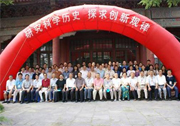| 英文摘要: |
Hybrid rice technology in China was developed in three stages. From the 1950s onwards, hybrid rice researchers, as typified by Yuan Longping, sought out a feasible approach to utilizing rice heterosis, and developed the three-line indica hybrid rice. Led by the government, the hybrid rice technology R&D teams adopted the research mode of “large-scale cooperation” (大协作), and accomplished technical innovations in the three-line system, selective breeding, and production of hybrid seeds. In the ensuing decade, Yuan Longping and others discovered the photo-thermo sensitive genic male sterility (PTGMS) of rice and developed PTGMS lines, turning highly advantageous two-line rice breeding from scientific vision into reality. Over the next twenty-five years, China’s super-rice breeding program integrated the conventional, three-line, and two-line breeding methods with modern molecular biotechnology methods. For nearly half a century, China made outstanding attainments in acquiring quality strains that yielded enormous economic and social benefits. Throughout this process, factors such as urgent social demand for increased grain production and scientific research cooperation provided significant impetus. |





